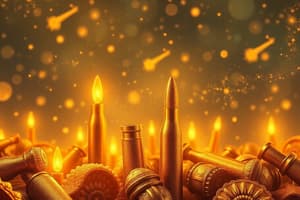Podcast
Questions and Answers
What is one of the main reasons why brass remains popular in ammunition manufacturing?
What is one of the main reasons why brass remains popular in ammunition manufacturing?
- It is eco-friendly
- It is inexpensive
- It can withstand heat well (correct)
- It is lightweight
Which of the following metals also find applications in different forms of ammunition apart from brass?
Which of the following metals also find applications in different forms of ammunition apart from brass?
- Copper
- Aluminum (correct)
- Titanium
- Nickel
What is one of the manufacturing processes involved in making cartridges that ensures consistency across each batch?
What is one of the manufacturing processes involved in making cartridges that ensures consistency across each batch?
- Bending
- Welding
- Crimping (correct)
- Stamping
Why is precision important in the manufacturing of cartridges?
Why is precision important in the manufacturing of cartridges?
How does the right choice of ammunition impact the outcome of activities like hunting, sport shooting, or military operations?
How does the right choice of ammunition impact the outcome of activities like hunting, sport shooting, or military operations?
What are the three basic components of a cartridge?
What are the three basic components of a cartridge?
How do rifle cartridges differ from shotgun shells in terms of projectile design?
How do rifle cartridges differ from shotgun shells in terms of projectile design?
Which component of the cartridge retains the gases produced by the burning powder propellant?
Which component of the cartridge retains the gases produced by the burning powder propellant?
What role does the design of the cartridge play in determining?
What role does the design of the cartridge play in determining?
In terms of impact spread upon discharge, what is the purpose of multiple lead pellets in shotgun shells?
In terms of impact spread upon discharge, what is the purpose of multiple lead pellets in shotgun shells?
Why do rifle cartridges typically have pointed bullets?
Why do rifle cartridges typically have pointed bullets?
Flashcards
Cartridge
Cartridge
A complete unit of ammunition, containing a casing, propellant charge, and bullet.
Ammunition Categories
Ammunition Categories
Small arms and large arms ammunition.
Casing
Casing
The container that holds all components of a cartridge together.
Propellant Charge
Propellant Charge
Signup and view all the flashcards
Bullet
Bullet
Signup and view all the flashcards
Rifle Cartridges
Rifle Cartridges
Signup and view all the flashcards
Shotgun Shells
Shotgun Shells
Signup and view all the flashcards
Brass in Cartridges
Brass in Cartridges
Signup and view all the flashcards
Cartridge Manufacturing
Cartridge Manufacturing
Signup and view all the flashcards
Cartridge Design
Cartridge Design
Signup and view all the flashcards
Study Notes
Ammunition is a crucial component of any firearm system. It consists of several parts working together to ensure efficient and effective functioning. Let's delve into the world of ammunition, specifically focusing on its primary building block - the cartridge.
Understanding the Cartridge
Ammunition can generally be classified into two main categories: small arms ammunition and large arms ammunition. Within these broad classifications, the most common form of ammunition is the cartridge, which consists of three basic components: a casing, propellant charge, and projectile bullet. These components work harmoniously during firing, with the case retaining the gases produced by the burning powder propellant to push the bullet out of the barrel and towards the target.
Cartridges come in various shapes, sizes, and types depending on their intended purpose. For example, rifle cartridges typically have a pointed bullet to pierce through targets, while shotgun shells contain multiple lead pellets that spread out upon discharge, creating a wider field of impact. The design of the cartridge determines factors such as velocity, range, penetration, and accuracy, all of which play a significant role in determining the overall effectiveness of the ammunition.
Material and Manufacturing Processes
The materials used to manufacture cartridges can vary greatly due to the diverse purposes they serve. Generally speaking, brass remains popular for its pliability and ability to hold up well under heat during firing. However, other metals like aluminum or steel also find applications in different forms of ammunition.
Manufacturing processes for cartridges involve several steps including metal forming, extrusion, crimping, and final assembly. These intricate procedures require precision and quality control measures to ensure consistency across each batch of ammunition, ensuring they function reliably under pressure.
In conclusion, the cartridge plays a pivotal role in understanding ammunition. Its composition, manufacturing processes, and variety highlight both the versatility and complexity inherent in designing effective ammunition systems. Whether it's for hunting, sport shooting, self-defense, or military operations, the right choice of ammunition can make all the difference in achieving the desired outcome.
Studying That Suits You
Use AI to generate personalized quizzes and flashcards to suit your learning preferences.




